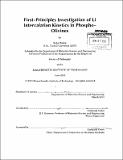| dc.contributor.advisor | Gerbrand Ceder. | en_US |
| dc.contributor.author | Malik, Rahul | en_US |
| dc.contributor.other | Massachusetts Institute of Technology. Department of Materials Science and Engineering. | en_US |
| dc.date.accessioned | 2013-09-24T19:40:12Z | |
| dc.date.available | 2013-09-24T19:40:12Z | |
| dc.date.copyright | 2013 | en_US |
| dc.date.issued | 2013 | en_US |
| dc.identifier.uri | http://hdl.handle.net/1721.1/81060 | |
| dc.description | Thesis (Ph. D.)--Massachusetts Institute of Technology, Dept. of Materials Science and Engineering, 2013. | en_US |
| dc.description | Cataloged from PDF version of thesis. | en_US |
| dc.description | Includes bibliographical references (p. 141-150). | en_US |
| dc.description.abstract | This thesis focuses broadly on characterizing and understanding the Li intercalation mechanism in phospho-olivines, namely LiFePO₄ and Li(Fe,Mn)PO₄, using first-principles calculations. Currently Li-ion battery technology is critically relied upon for the operation of electrified vehicles, but further improvements mainly in cathode performance are required to ensure widespread adoption, which in itself requires learning from existing commercial cathode chemistries. LiFePO₄ is presently used in commercial Li-ion batteries, known for its rapid charge and discharge capability but with underwhelming energy density. This motivates the three central research efforts presented herein. First, we investigate the modified phase diagram and electrochemical properties of mixed olivines, such as Li(Fe,Mn)PO₄, which offer improved theoretical energy density over LiFePO₄ (due to the higher redox voltage associated with Mn²+/Mn³+). The Lix(FelyMny)PO₄ phase diagram is constructed by Monte Carlo simulation on a cluster expansion Hamiltonian parametrized by first-principles determined energies. Deviations from the equilibrium phase behavior and voltages of pure LiFePO₄ and LiMnPO₄ are analyzed and discussed to good agreement with experimental observations. Second, we address why LiFePO₄ exhibits superior rate performance strictly when the active particle size is brought down to the nano-scale. By considering the presence of immobile point defects residing in the 1D Li diffusion path, specifically by calculating from first principles both defect formation energies and Li migration barriers in the vicinity of likely defects, the Li diffusivity is recalculated and is found to strongly vary with particle size. At small particle sizes, the contribution from defects is small, and fast 1D Li diffusion is accessible. However, at larger particle sizes (pm scale and above) the contribution from defects is much larger. Not only is Li transport impeded, but it is also less anisotropic in agreement with experiments on large LiFePO₄ single crystals. Third, we investigate why LiFePO₄ can be charged and discharged rapidly despite having to undergo a first-order phase transition. Conventional wisdom dictates that a system with strong equilibrium Li segregation behavior requires both nucleation and growth in the charge and discharge process, which should impede the overall kinetics. Rather, through first-principles calculations, we determine the minimal energy required to access a non-equilibrium transformation path entirely through the solid solution. Not only does this transformation mechanism require little driving force, but it also rationalizes how a kinetically favorable but nonequilibrium path is responsible for the extremely high rate performance associated with this material. The consequences of a rapid non-equilibrium single-particle transformation mechanism on (dis)charging a multi-particle assembly, as is the case in porous electrodes, are discussed and compared to experimental observations. | en_US |
| dc.description.statementofresponsibility | by Rahul Malik. | en_US |
| dc.format.extent | 150 p. | en_US |
| dc.language.iso | eng | en_US |
| dc.publisher | Massachusetts Institute of Technology | en_US |
| dc.rights | M.I.T. theses are protected by
copyright. They may be viewed from this source for any purpose, but
reproduction or distribution in any format is prohibited without written
permission. See provided URL for inquiries about permission. | en_US |
| dc.rights.uri | http://dspace.mit.edu/handle/1721.1/7582 | en_US |
| dc.subject | Materials Science and Engineering. | en_US |
| dc.title | First-principles investigation of Li intercalation kinetics in phospho-olivines | en_US |
| dc.type | Thesis | en_US |
| dc.description.degree | Ph.D. | en_US |
| dc.contributor.department | Massachusetts Institute of Technology. Department of Materials Science and Engineering | |
| dc.identifier.oclc | 857792197 | en_US |
